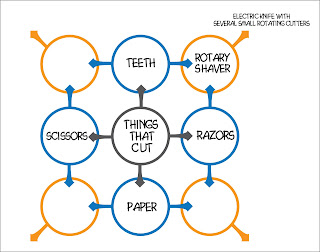Strong ideation can take many forms, and involve many different techniques and approaches. Knowing which methods to use for certain types of innovation initiatives and problems can be a challenge. Some methods are well suited for complex technical challenges, while others are better suited for aesthetic or form challenges. Some approaches work reasonably well on an individual basis, while others are most effective in a group setting. I will devote a series of posts to discussing various ideation techniques I’ve found effective, how to do them, and when to use them.
This post focuses on an ideation method which I call “Diagonal Thinking” or “Forced Diagonals”. This method involves starting with a central theme, and building ideas off of that theme. Then the challenging part of the method is to require the creation of new ideas which combine two or more of the basic ideas in some way. Though this method can be challenging, I’ve found that it can lead to the creation of a variety of unique and strong ideas.
Methods. This technique can work in a variety of different ways, and you should adjust the methodology based on the personality of the group and the subject area of your ideation. For any method, the facilitator should introduce the problem/challenge and pace the event. Remember to focus on generating a large quantity of ideas, and use a timer to instill a sense of urgency for participants to create ideas quickly.
Example Method: On a sheet of paper, a whiteboard, or whatever media you choose, create a grid of nine squares or circles (3 x 3). In the center circle, write a fundamental characteristic or goal related to the topic you are ideating. For example, if you are trying to ideate new types of electric knives, you might write “things that cut” or “ways to cut” in the center circle.
 |
| Forced Diagonals Method Example |
Next, have each participant (or yourself, if ideating alone) populate the circles directly above, below, to the right of, and to the left of the central circle, with an example of something that relates to what is written in the center circle. To continue our example, if we wrote “things that cut” in the central circle, we might populate the four adjacent circles with “scissors”, “teeth”, “paper” (eg, paper cuts), and “razor blades”. Try to encourage creativity in filling the circles.
Now, in each of the corner circles, write an idea or concept that somehow combines the ideas in each of the two adjacent circles. This effort can require some mental stretching, but don’t give up – populate every circle, even if the idea is a little silly or exotic. For example, if our top circle is “teeth” and our right circle is “razor blades” we might populate the top right circle with “Rotary shaver”. A rotary shaver typically includes several small blades that look kind of like teeth.
Lastly, take each corner idea or concept and tie it back to your ideation space with a new concept or idea. So, if we populated a corner circle with “Rotary Shaver” and we’re ideating new types of electric knives, we might create an idea for an electric knife made up of a series of small rotary cutting blades.
When to use: Diagonal thinking is a good method for going deeper, after basic ideation techniques have reached a point of diminishing returns. It forces participants to think into new corners, and can often yield ideas in areas that would otherwise be missed. This technique makes a good solo or group activity.
When not to use: I would not recommend starting an ideation event with this technique. This may also not be a good technique to use if your topic space is very broad, since it will not force thinking deep into corners. For example, if your topic space is “toys” that might be a bit broad for this technique. But, feel free to try it; if you’ve got the right creative group it may still work well.
No comments:
Post a Comment
Thank you for your interest in the Product Innovation Blog. I welcome your comments and suggestions.